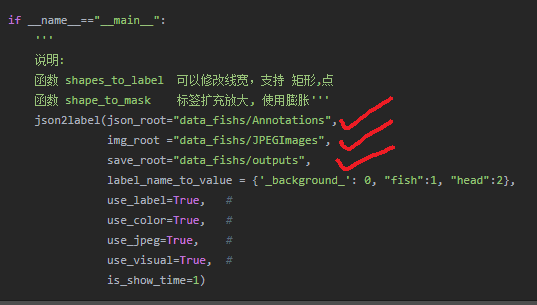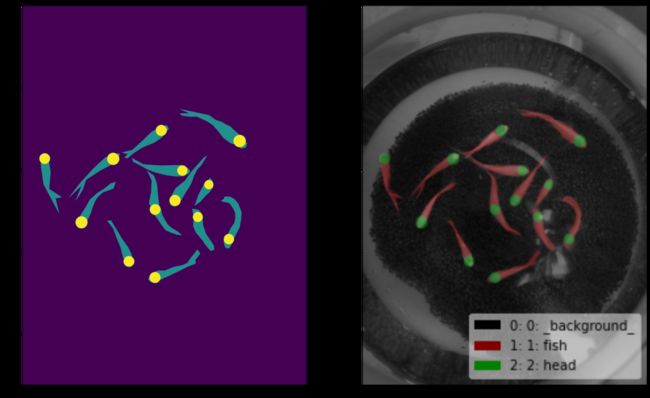图像语义分割实践(一)标签制作与转换
语义分割实践过程中,网上常用公开数据集和模型都是打包固化的,只要配置环境一致就可以进行所谓“复现”,但是这种拿来主义很被动,很多人陷入邯郸学步,贪多嚼不烂的窘迫感,最后浪费大把时间。因此,我觉得真正要学得深入,就得一点一滴进行实现,才能形成自己的一套体系。
手把手视频讲解+代码讲解
1.如何实现输入(完全免费解析直达,致力干货分享)
2.如何实现模型(完全免费解析直达,致力干货分享)
3.如何实现输出(完全免费解析直达,致力干货分享)
第1步:使用 labelme 打标
pip install labelme
运行labelme,使用labelme进行打标,打标效果图如下图。

第2步:使用 json2label 函数进行标签转换
复制文末代码命名为genlabel.py,修改"main"底下的数据路径与标签映射,运行genlabel.py函数,生成分割标签掩码。


genlabel.py函数
import shutil,base64,io,os,json,glob,math,warnings
import numpy as np
import PIL
import cv2
from PIL import (ExifTags, Image, ImageOps, ImageDraw, ImageDraw, ImageFont)
from skimage import img_as_ubyte
import tensorflow as tf
import os.path as osp
from tqdm import trange
import matplotlib.pyplot as plt
''' @定制化标签 '''
def shape_to_mask(img_shape, points, shape_type=None,
line_width=10, point_size=5):
mask = np.zeros(img_shape[:2], dtype=np.uint8)
mask = PIL.Image.fromarray(mask)
draw = PIL.ImageDraw.Draw(mask)
xy = [tuple(point) for point in points]
if shape_type == 'circle':
assert len(xy) == 2, 'Shape of shape_type=circle must have 2 points'
(cx, cy), (px, py) = xy
d = math.sqrt((cx - px) ** 2 + (cy - py) ** 2)
draw.ellipse([cx - d, cy - d, cx + d, cy + d], outline=1, fill=1)
elif shape_type == 'rectangle':
assert len(xy) == 2, 'Shape of shape_type=rectangle must have 2 points'
draw.rectangle(xy, outline=1, fill=1)
elif shape_type == 'line':
assert len(xy) == 2, 'Shape of shape_type=line must have 2 points'
draw.line(xy=xy, fill=1, width=line_width)
elif shape_type == 'linestrip':
draw.line(xy=xy, fill=1, width=line_width)
elif shape_type == 'point':
assert len(xy) == 1, 'Shape of shape_type=point must have 1 points'
cx, cy = xy[0]
r = point_size
draw.ellipse([cx - r, cy - r, cx + r, cy + r], outline=1, fill=1)
else:
assert len(xy) > 2, 'Polygon must have points more than 2'
draw.polygon(xy=xy, outline=1, fill=1) # xy 为[(x,y),(x.y),(...,...),...]
pass
'''
################### 定制化标签 ###################
此处可根据需要打标签图draw进行自定义业务标签
'''
mask = np.array(mask, dtype=bool)
return mask
def img_b64_to_arr(img_b64):
f = io.BytesIO()
f.write(base64.b64decode(img_b64))
img_arr = np.array(PIL.Image.open(f))
return img_arr
def img_arr_to_b64(img_arr): #没调用
img_pil = PIL.Image.fromarray(img_arr)
f = io.BytesIO()
img_pil.save(f, format='PNG')
img_bin = f.getvalue()
if hasattr(base64, 'encodebytes'):
img_b64 = base64.encodebytes(img_bin)
else:
img_b64 = base64.encodestring(img_bin)
return img_b64
def img_data_to_png_data(img_data): # 没调用
with io.BytesIO() as f:
f.write(img_data)
img = PIL.Image.open(f)
with io.BytesIO() as f:
img.save(f, 'PNG')
f.seek(0)
return f.read()
def apply_exif_orientation(image): #没调用
try:
exif = image._getexif()
except AttributeError:
exif = None
if exif is None:
return image
exif = {
PIL.ExifTags.TAGS[k]: v
for k, v in exif.items()
if k in PIL.ExifTags.TAGS
}
orientation = exif.get('Orientation', None)
if orientation == 1:
# do nothing
return image
elif orientation == 2:
# left-to-right mirror
return PIL.ImageOps.mirror(image)
elif orientation == 3:
# rotate 180
return image.transpose(PIL.Image.ROTATE_180)
elif orientation == 4:
# top-to-bottom mirror
return PIL.ImageOps.flip(image)
elif orientation == 5:
# top-to-left mirror
return PIL.ImageOps.mirror(image.transpose(PIL.Image.ROTATE_270))
elif orientation == 6:
# rotate 270
return image.transpose(PIL.Image.ROTATE_270)
elif orientation == 7:
# top-to-right mirror
return PIL.ImageOps.mirror(image.transpose(PIL.Image.ROTATE_90))
elif orientation == 8:
# rotate 90
return image.transpose(PIL.Image.ROTATE_90)
else:
return image
def polygons_to_mask(img_shape, polygons, shape_type=None):
warnings.warn(
"The 'polygons_to_mask' function is deprecated, "
"use 'shape_to_mask' instead."
)
return shape_to_mask(img_shape, points=polygons, shape_type=shape_type)
def shapes_to_label(img_shape, shapes, label_name_to_value, type='class'):
assert type in ['class', 'instance']
cls = np.zeros(img_shape[:2], dtype=np.int32)
if type == 'instance':
ins = np.zeros(img_shape[:2], dtype=np.int32)
instance_names = ['_background_']
for shape in shapes:
points = shape['points']
label = shape['label']
shape_type = shape.get('shape_type', None)
if type == 'class':
cls_name = label
elif type == 'instance':
cls_name = label.split('-')[0]
if label not in instance_names:
instance_names.append(label)
ins_id = instance_names.index(label)
cls_id = label_name_to_value[cls_name]
#mask = shape_to_mask(img_shape[:2], points, shape_type) # detail
mask = shape_to_mask(img_shape[:2], points, shape_type, line_width=10, point_size=5) # detail
cls[mask] = cls_id # 对每个label进行赋值类别
if type == 'instance':
ins[mask] = ins_id
pass
pass
if type == 'instance':
return cls, ins
return cls
def labelme_shapes_to_label(img_shape, shapes):
warnings.warn('labelme_shapes_to_label is deprecated, so please use '
'shapes_to_label.')
label_name_to_value = {'_background_': 0}
for shape in shapes:
label_name = shape['label']
if label_name in label_name_to_value:
label_value = label_name_to_value[label_name]
else:
label_value = len(label_name_to_value)
label_name_to_value[label_name] = label_value
lbl = shapes_to_label(img_shape, shapes, label_name_to_value)
return lbl, label_name_to_value
def masks_to_bboxes(masks):
if masks.ndim != 3:
raise ValueError(
'masks.ndim must be 3, but it is {}'
.format(masks.ndim)
)
if masks.dtype != bool:
raise ValueError(
'masks.dtype must be bool type, but it is {}'
.format(masks.dtype)
)
bboxes = []
for mask in masks:
where = np.argwhere(mask)
(y1, x1), (y2, x2) = where.min(0), where.max(0) + 1
bboxes.append((y1, x1, y2, x2))
bboxes = np.asarray(bboxes, dtype=np.float32)
return bboxes
def label_colormap(N=256):
def bitget(byteval, idx):
return ((byteval & (1 << idx)) != 0)
cmap = np.zeros((N, 3))
for i in range(0, N):
id = i
r, g, b = 0, 0, 0
for j in range(0, 8):
r = np.bitwise_or(r, (bitget(id, 0) << 7 - j))
g = np.bitwise_or(g, (bitget(id, 1) << 7 - j))
b = np.bitwise_or(b, (bitget(id, 2) << 7 - j))
id = (id >> 3)
cmap[i, 0] = r
cmap[i, 1] = g
cmap[i, 2] = b
cmap = cmap.astype(np.float32) / 255
return cmap
def _validate_colormap(colormap, n_labels):
if colormap is None:
colormap = label_colormap(n_labels)
else:
assert colormap.shape == (colormap.shape[0], 3), \
'colormap must be sequence of RGB values'
assert 0 <= colormap.min() and colormap.max() <= 1, \
'colormap must ranges 0 to 1'
return colormap
# similar function as skimage.color.label2rgb
def label2rgb(
lbl, img=None, n_labels=None, alpha=0.5, thresh_suppress=0, colormap=None,
):
if n_labels is None:
n_labels = len(np.unique(lbl))
colormap = _validate_colormap(colormap, n_labels)
colormap = (colormap * 255).astype(np.uint8)
lbl_viz = colormap[lbl]
lbl_viz[lbl == -1] = (0, 0, 0) # unlabeled
if img is not None:
img_gray = PIL.Image.fromarray(img).convert('LA')
img_gray = np.asarray(img_gray.convert('RGB'))
# img_gray = cv2.cvtColor(img, cv2.COLOR_RGB2GRAY)
# img_gray = cv2.cvtColor(img_gray, cv2.COLOR_GRAY2RGB)
lbl_viz = alpha * lbl_viz + (1 - alpha) * img_gray
lbl_viz = lbl_viz.astype(np.uint8)
pass
return lbl_viz
def draw_label(label, img=None, label_names=None, colormap=None, **kwargs):
"""Draw pixel-wise label with colorization and label names.
label: ndarray, (H, W)
Pixel-wise labels to colorize.
img: ndarray, (H, W, 3), optional
Image on which the colorized label will be drawn.
label_names: iterable
List of label names.
"""
backend_org = plt.rcParams['backend']
plt.switch_backend('agg')
plt.subplots_adjust(left=0, right=1, top=1, bottom=0,
wspace=0, hspace=0)
plt.margins(0, 0)
plt.gca().xaxis.set_major_locator(plt.NullLocator())
plt.gca().yaxis.set_major_locator(plt.NullLocator())
if label_names is None:
label_names = [str(l) for l in range(label.max() + 1)]
colormap = _validate_colormap(colormap, len(label_names))
label_viz = label2rgb(
label, img, n_labels=len(label_names), colormap=colormap, **kwargs
)
plt.imshow(label_viz)
plt.axis('off')
plt_handlers = []
plt_titles = []
for label_value, label_name in enumerate(label_names):
if label_value not in label:
continue
fc = colormap[label_value]
p = plt.Rectangle((0, 0), 1, 1, fc=fc)
plt_handlers.append(p)
plt_titles.append('{value}: {name}'
.format(value=label_value, name=label_name))
plt.legend(plt_handlers, plt_titles, loc='lower right', framealpha=.5)
f = io.BytesIO()
plt.savefig(f, bbox_inches='tight', pad_inches=0)
plt.cla()
plt.close()
plt.switch_backend(backend_org)
out_size = (label_viz.shape[1], label_viz.shape[0])
out = PIL.Image.open(f).resize(out_size, PIL.Image.BILINEAR).convert('RGB')
out = np.asarray(out)
return out
def draw_instances(
image=None,
bboxes=None,
labels=None,
masks=None,
captions=None,
):
# TODO(wkentaro)
assert image is not None
assert bboxes is not None
assert labels is not None
assert masks is None
assert captions is not None
viz = PIL.Image.fromarray(image)
draw = PIL.ImageDraw.ImageDraw(viz)
font_path = osp.join(
osp.dirname(matplotlib.__file__),
'mpl-data/fonts/ttf/DejaVuSans.ttf'
)
font = PIL.ImageFont.truetype(font_path)
colormap = label_colormap(255)
for bbox, label, caption in zip(bboxes, labels, captions):
color = colormap[label]
color = tuple((color * 255).astype(np.uint8).tolist())
xmin, ymin, xmax, ymax = bbox
draw.rectangle((xmin, ymin, xmax, ymax), outline=color)
draw.text((xmin, ymin), caption, font=font)
return np.asarray(viz)
def lblsave(filename, lbl):
if os.path.splitext(filename)[1] != '.png':
filename += '.png'
# Assume label ranses [-1, 254] for int32,
# and [0, 255] for uint8 as VOC.
if lbl.min() >= -1 and lbl.max() < 255:
lbl_pil = PIL.Image.fromarray(lbl.astype(np.uint8), mode='P')
colormap = label_colormap(255)
lbl_pil.putpalette((colormap * 255).astype(np.uint8).flatten())
lbl_pil.save(filename)
else:
raise ValueError(
'[%s] Cannot save the pixel-wise class label as PNG. '
'Please consider using the .npy format.' % filename
)
pass
pass
def json2label(json_root="dataset\\2021-08-30", img_root="dataset\\2021-08-30", save_root="dataset\\2021-08-30",
label_name_to_value = {'_background_': 0, "object":1, "flaw":2},
use_label=True, use_color=True, use_jpeg=True, use_visual=True,
is_show_time=1):
####### 默认输出路径 ########
save_img=os.path.join(save_root, "JPEGImages")
save_ano=os.path.join(save_root, "Annotations")
save_label=os.path.join(save_root, "SegmentationClassRaw")
save_color=os.path.join(save_root, "SegmentationClassPNG")
save_visual=os.path.join(save_root, "SegmentationClassVisualization")
if use_jpeg and not os.path.exists(save_img):
os.makedirs(save_img)
if use_label and not os.path.exists(save_ano):
os.makedirs(save_ano)
if use_color and not os.path.exists(save_color):
os.makedirs(save_color)
if use_label and not os.path.exists(save_label):
os.makedirs(save_label)
if use_visual and not os.path.exists(save_visual):
os.makedirs(save_visual)
pass
# 检索对应的json和img
img_dirs=glob.glob(os.path.join(img_root, "*[jpg,JPG,JPEG,bmp,BMP]")) # list 的文件
print("当前root下有图片个数: ", len(img_dirs))
for j in trange(len(img_dirs)):
img_dir=img_dirs[j]
path,name=os.path.split(img_dir)
first,second=os.path.splitext(name)
json_dir=os.path.join(json_root, first+".json")
if not os.path.exists(img_dir) or not os.path.isfile(img_dir):
print("no_exists: ", j, img_dir)
continue
pass
if not os.path.exists(json_dir) or not os.path.isfile(json_dir):
print("no_exists: ", j, json_dir)
continue
pass
# 进行json解析和标签转换
if os.path.isfile(json_dir):
data = json.load(open(json_dir))
pass
if data['imageData']:
imageData = data['imageData']
else:
with open(img_dir, 'rb') as f:
imageData = f.read()
imageData = base64.b64encode(imageData).decode('utf-8')
pass
pass
''' 解析图片: img : (array type) '''
img = img_b64_to_arr(imageData)
# mask the label_name
for shape in data['shapes']:
label_name = shape['label'] # 获取label名
if label_name in label_name_to_value:
label_value = label_name_to_value[label_name]
else:
label_value = len(label_name_to_value)
label_name_to_value[label_name] = label_value
label_values, label_names = [], []
for ln, lv in sorted(label_name_to_value.items(), key=lambda x: x[1]):
label_values.append(lv)
label_names.append(ln)
pass
if label_values != list(range(len(label_values))):
print("assert label_values")
''' 解析标签: "seg_label" lbl已经为0,1,2,3,的标签了 '''
lbl = shapes_to_label(img.shape, data['shapes'], label_name_to_value)
''' 掩码可视化:"draw_mask" lbl_viz '''
captions = ['{}: {}'.format(lv, ln)
for ln, lv in label_name_to_value.items()]
lbl_viz = draw_label(lbl, img, captions)
if is_show_time>0:
is_show_time-=1
plt.figure(figsize=(20,20))
plt.subplot(121)
plt.imshow(lbl)
plt.subplot(122)
plt.imshow(lbl_viz)
plt.show()
pass
# 保存为统一图片
if use_jpeg:
PIL.Image.fromarray(img).save(os.path.join(save_img, first+".jpeg"))
# 保存为数字标签图
if use_label:
with tf.io.gfile.GFile(os.path.join(save_label, first+".png"), mode='w') as f:
Image.fromarray(lbl.astype(dtype=np.uint8)).save(f, 'PNG')
# 保存为彩色标签图
if use_color:
lblsave(os.path.join(save_color, first+".png"), lbl)
# 保存为掩码可视化
if use_visual:
PIL.Image.fromarray(lbl_viz).save(os.path.join(save_visual, first+".png"))
# 移动一份数据-到aon和jpg文件夹,统一输出格式
if use_label:
shutil.move(img_dir, os.path.join(save_ano, name)) if os.path.exists(img_dir) else None
shutil.move(json_dir, os.path.join(save_ano, first+".json")) if os.path.exists(json_dir) else None
pass
pass
pass
if __name__=="__main__":
'''
说明:
函数 shapes_to_label 可以修改线宽,支持 矩形,点
函数 shape_to_mask 标签扩充放大, 使用膨胀'''
json2label(json_root="data_fishs/Annotations",
img_root ="data_fishs/JPEGImages",
save_root="data_fishs/outputs",
label_name_to_value = {'_background_': 0, "fish":1, "head":2},
use_label=True, #
use_color=True, #
use_jpeg=True, #
use_visual=True, #
is_show_time=1)
参考链接
# >> !pip install -r requirements.txt
from json_to_dataset import mk_dataset
class args:
label_name_to_value = {'_background_': 0, 'center':1} # 指定标签映射
json_file = "./data" # json路径
image_file = "./data" # 图片路径
img_type = "bmp" # 图片类型
out_dir = "./data" # 输出路径
is_RGBLabel = True # 保存 COLOR 标签图
is_GRAYLabel = True # 保存 LABEL 标签图
is_MASK = True # 保存 Makrs 掩码图
pass
mk_dataset(args.json_file, args.image_file, args.out_dir, args.label_name_to_value,
args.img_type,
args.is_RGBLabel,
args.is_GRAYLabel,
args.is_MASK)
print("finish")
源码下载
